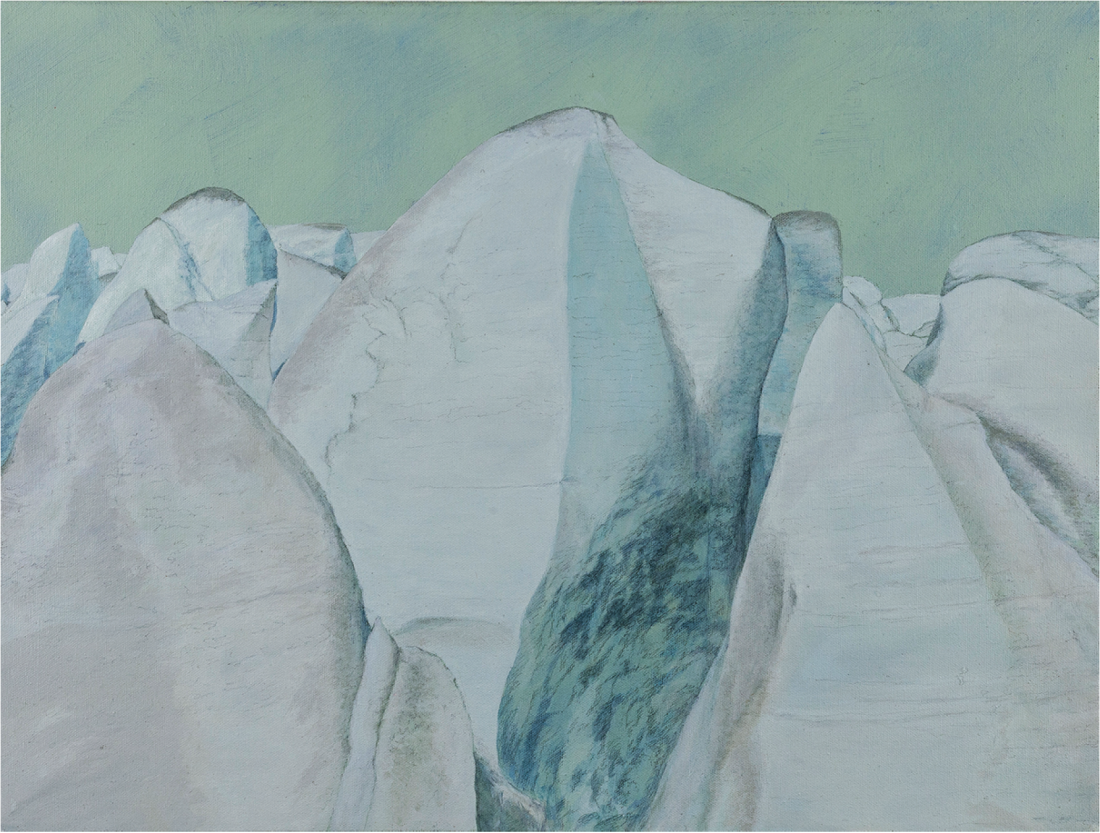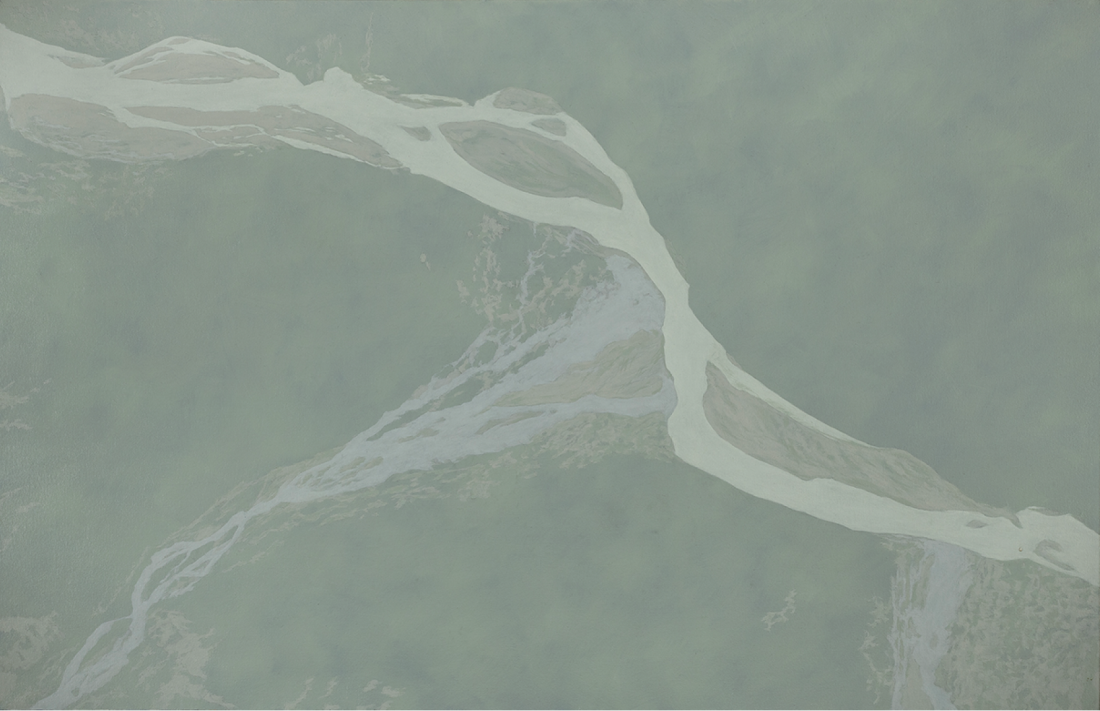Leslie Reid
You would think that global warming would have melted the myth of the “Far North” as fast as it is melting the glaciers themselves. But the idea of the Arctic as a vast space of crystalline purity untouched by civilization, a silent signifier of spiritual communion between infinite Nature and Man, though disproven by climate change and deconstructed in critical literature and art, lives on in the Canadian subconscious. Arguably, it owes its resilience to the iconic Arctic paintings of Lawren Harris and countless other reiterations of a mystical North in literature, art and popular culture. But for such a myth to gain track in the first place, it must speak to a human desire to lose oneself in a Nature that is seen as an order more powerful and enduring than human life.
And so it was that when I entered Leslie Reid’s exhibition “Glacial,” at Galerie Laroche/Joncas in Montréal, and was surrounded by paintings of still, icy, vast and empty spaces, I felt, at first, a tug of the sublime, a longing for such an infinite, pure Nature to exist and absorb my human, finite existence. As modest in size as this exhibition of seven paintings is, it bears witness to the strength of the human longing for transcendence and the persistence of the North as a dream-image for its fulfillment. Reid’s paintings, haunted by past ethereal representations of the North, first draw the viewer deeply into this myth and then implicate the artist herself as well as the viewers in sustaining this dream. Knowing better, we now have to work on waking up. The paintings provide subtle subversions that point away from the delusions of transcendence to the reality of an endangered earth.
The works are based on aerial photographs of the Kaskawulsh Glacier, a large ice field in the northern Yukon Territory that flows into the Pacific Ocean, and the Llewellyn Glacier, part of the Juneau Icefield, along the northern end of the Coast Mountains of Alaska and British Columbia. The map-like images of the Kaskawulsh show the flow of glacial melt-waters. Kaskawulsh III is blue and icy; the other two paintings reveal innumerable wispy, winding lines that form pale traces of the shifting patterns of glacial waters.

Leslie Reid, Llewellyn IV 59˚04’N; 134˚05’W, 2015, oil and graphite on canvas, 18 x 24 inches. Photograph: Justin Wonnacott. Image courtesy the artist and Laroche/Joncas, Montreal.
Reid’s painting technique of layering subtle colour shifts results in a veiled, distanced imagery that at first struck me as unearthly and then as a recognition of the earth’s fragility. The earth fades away in the “Kaskawulsh” paintings; in the large Llewllyn painting, a mountain in the background is veiled to the point of disappearance, while rows of crevasses completely fill the fore and middle ground. These ice peaks are brought close to the viewer and appear to be sliding into our space. The smaller paintings of the Llewellyn show close-ups of peaks carrying pulverized rock on their sides and tops, like grit on the melting snowbanks in our cities. The grey traces serve to break the spell of white perfection.
Close reading of the paintings, then, brings us back to earth and to the human impact on Nature. The complex inter-relationship between Nature and culture has been a consistent theme in Reid’s practice, spanning over four decades. She paints places she has seen and experienced, places that mean something to her personally, and to her family. Diana Nemiroff, who curated a retrospective exhibition of Reid’s work at Carleton University in 2011, wrote about her landscape paintings that “the light and spaces of the natural world slowly and inevitably become metaphors for wordless feelings—from plenitude to emptiness, and hopefulness to dread.” It is, perhaps, because of Reid’s reliance on personal perception and emotion that she can look back on a remarkably consistent oeuvre of more than 40 years, which nonetheless looks fresh and topical in every new body of work.
“Glacial” underscores this. The paintings in the exhibition are the first works of a new, audacious project she began in the summer of 2013 with a three-week residency in the North as part of the Canadian Forces Artists Program. In the coming years, she will continue to explore the videos and photographs she took when accompanying the military on their annual sovereignty operations throughout Northern Canada and the High Arctic, flying in a Hercules aircraft and Griffon helicopters. Many of the areas she flew over were first photographed by Royal Canadian Air Force photo squadrons after the Second World War. Since her father, who was an Air Force pilot, had flown with the squadrons for several years, this new project brings together themes of family and landscape and the changes wrought by time.

Leslie Reid, Kaskawulsh III 60˚44’N; 138˚04’W, 2014, oil and graphite on canvas, 32 x 50 inches. Photograph: Justin Wonnacott. Image courtesy the artist and Laroche/Joncas, Montreal.
Millions of photographs were taken by the RCAF after WWII for the first accurate mapping project of the Far North. As a border area between the Soviet Union and the West, the Canadian Arctic gained political importance in the Cold War and maps were needed for the establishment of military installations such as the DEW Line (distant early warning line). The North continues to be a flashpoint for conflicting interests of sovereignty, resources and preservation, inevitably affecting the lives of Northern peoples.
Reid joins a roster of Canadian artists, including Inuit artists, who have contested the myth of a unified Nature of the North as a screen that silences the multiplicity and complexity of the peoples and nature who are a living part of it. She writes: “Issues of displacement, refuge and survival, fragility and resilience, of places and peoples, have become ever more critical to my exploration of our relationship to the earth.” While multimedia exhibitions planned for Ottawa and Calgary will touch ground and bring in people and places, “Glacial” is an overture, an elegy for an enduring myth, disputed by the realities of the present landscape of the North. ❚
“Glacial” was exhibited at Galerie Laroche/Joncas, Montreal, from March 5 to April 11, 2015.
Petra Halkes, based in Ottawa, is an artist, independent curator and art writer. She writes regularly for Canadian art magazines.

